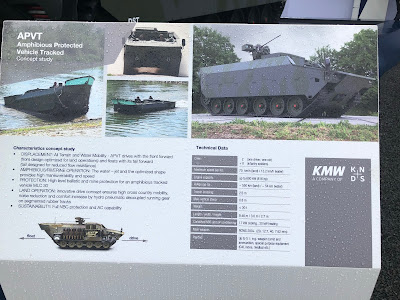18 Juni 2018
The APVT is fully amphibious and is propelled in the water by a single waterjet. (photos : KMW, BMPD)
Krauss-Maffei Wegmann (KMW) unveiled a concept demonstrator for its self-funded Amphibious Protected Vehicle Tracked (APVT) programme.
The first example is configured as an armoured personnel carrier (APC), which is operated by a two-person crew and carries eight dismounts.
The hull is of welded steel with additional buoyancy aids fitted to either side.
According to KMW, the APVT is 9.46 m long, 3.0 m wide, and 2.7 m tall with a gross vehicle weight of 30 tonnes. It carries a five-tonne payload capacity for the weapon station, ammunition, fuel, and crew.
The vehicle is fitted with a hydropneumatic decoupled suspension system, which enables it to cross a 2.5 m trench and climb a vertical obstacle of up to 0.8 m.
The road wheels are adapted from the Puma infantry fighting vehicle, which is already in service with the German Army.
The APVT also features Defense Service Tracks (DST) composite rubber tracks, which are lighter, quieter, and generate less rolling resistance and vibration compared with conventional steel tracks, which reduces fuel consumption.
It is powered by a 816-hp MTU diesel engine coupled to an ZF automatic transmission, which gives a maximum road speed of up to 70 km/h with a range of up to 550 km.
During waterborne operations it is propelled by a waterjet, which provides a maximum speed of up to 13.2 km/h with a range of up to 54 km.
Preparation for amphibious operation includes activating the bilge pumps and erecting screens at the front and the rear.
A nuclear, biological, and chemical (NBC) system and an air conditioning system have also been installed to improve crew survivability and comfort.
(Jane's)
The APVT is fully amphibious and is propelled in the water by a single waterjet. (photos : KMW, BMPD)
Krauss-Maffei Wegmann (KMW) unveiled a concept demonstrator for its self-funded Amphibious Protected Vehicle Tracked (APVT) programme.
The first example is configured as an armoured personnel carrier (APC), which is operated by a two-person crew and carries eight dismounts.
The hull is of welded steel with additional buoyancy aids fitted to either side.
According to KMW, the APVT is 9.46 m long, 3.0 m wide, and 2.7 m tall with a gross vehicle weight of 30 tonnes. It carries a five-tonne payload capacity for the weapon station, ammunition, fuel, and crew.
The vehicle is fitted with a hydropneumatic decoupled suspension system, which enables it to cross a 2.5 m trench and climb a vertical obstacle of up to 0.8 m.
The road wheels are adapted from the Puma infantry fighting vehicle, which is already in service with the German Army.
The APVT also features Defense Service Tracks (DST) composite rubber tracks, which are lighter, quieter, and generate less rolling resistance and vibration compared with conventional steel tracks, which reduces fuel consumption.
It is powered by a 816-hp MTU diesel engine coupled to an ZF automatic transmission, which gives a maximum road speed of up to 70 km/h with a range of up to 550 km.
During waterborne operations it is propelled by a waterjet, which provides a maximum speed of up to 13.2 km/h with a range of up to 54 km.
Preparation for amphibious operation includes activating the bilge pumps and erecting screens at the front and the rear.
A nuclear, biological, and chemical (NBC) system and an air conditioning system have also been installed to improve crew survivability and comfort.
(Jane's)





